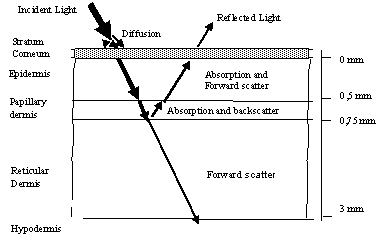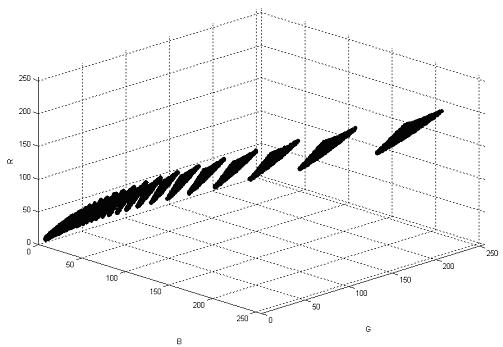Understanding how light interacts with skin can assist in designing physics-based dermatological image processing. The key is to understand how light interacts with skin tissue. The skin consists of different layers with different spectral properties.
When the incident light is applied to the skin layer, it is absorbed, and another part is scattered. The main layers of skin are as follows: Stratum cornea practically doesn’t absorb light but diffuses it; Epidermis consists of cells producing the pigment melanin. Melanin strongly absorbs light wavelengths towards the ultraviolet part; Dermis is next to the skin layer, consisting of collagen fibers. It can be split into two sublayers: The papillary dermis and the dermis itself. The papillary dermis consists of a high density of collagen fibbers who are strong scatterers of light. The primary requirement for the model is that light has to be scattered. Stratum cornea is supposed a scattering filter. Skin can be characterized as follows:
1) Epidermis, depending on wavelength, can be described with melanin absorption coefficient μamam(λ) and melanin concentration cm;
2) ed with hemoglobin absorption coefficient μah(λ), hemoglobin concentration ch, collagen scattering coefficient μspd and collagen layer thickness dpd;
3) Dermis can be described with scattering coefficient μsrd and thickness of layer dμsrd
Using those parameters the model of skin was calculated which shows reflected light dependency on skin parameters and wavelengths of light:
This color surface shows all available skin color values available. This color surface includes all races, sunburn degrees, or even age. All benign lessons where melanin is only in the epidermal layer also implies to this surface.








Any reference about the model and figure please?
yes, where is the reference for this model?
References:
http://www.cs.bham.ac.uk/~exc/Research/EPSRC_skin/epsrc_skin_project.html
http://www.cs.bham.ac.uk/~exc/Research/Papers/miua99.pdf
other links not working